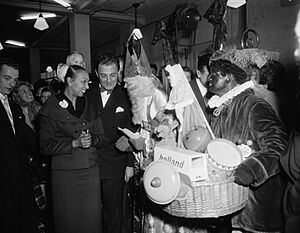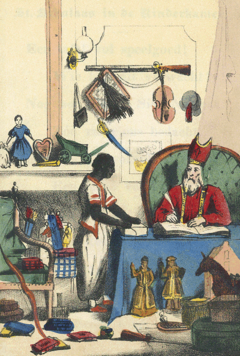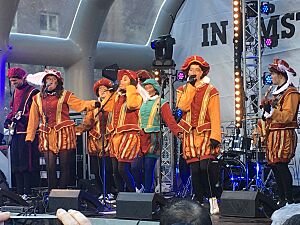Zwarte Piet facts for kids
|
A children's book from 1915, titled "In the Bag: the grave fate of naughty Grietje and Pietje", showing Zwarte Piet and his bag with naughty kids inside
|
|
| Other name(s) | Black Pete, Schwaarze Péiter, Swarte Pyt, Pit Hitam |
|---|---|
| Country | Netherlands, Belgium, Luxembourg, Curaçao, Aruba and Indonesia |
| Region | Benelux and former Dutch colonies |
| Habitat | Spain |
Zwarte Piet (which means Black Pete in English) is a special helper for Sinterklaas (Saint Nicholas) in the folklore of the Netherlands, Belgium, and Luxembourg. Zwarte Piet's main job is to help Sinterklaas give out sweets and gifts to children who have been good.
Over the years, how Zwarte Piet looks has changed quite a bit. The earliest pictures from the 1800s showed him as a dark-skinned person. For a long time, people playing Zwarte Piet wore dark makeup, colorful clothes, curly wigs, and bright red lipstick.
However, this traditional look became a topic of discussion in recent decades. Many people felt it was a stereotype and could be hurtful. Because of these discussions, a new version called Sooty Piet (Dutch: Roetveegpiet) became more common. Sooty Piet has the natural skin tone of the person playing the character, with dark smudges on their face, like they've been down a chimney. This updated look is now widely seen in celebrations, on TV, and in advertisements.
Contents
Celebrating Sinterklaas: Traditions and Fun
Zwarte Piet is an important part of the yearly Feast of Saint Nicholas. This celebration happens on the evening of 5 December in the Netherlands, Curaçao, and Aruba. On this night, children traditionally receive presents and sweets. In Belgium, the holiday is celebrated on 6 December.
Zwarte Piet appears in the weeks leading up to the main celebration. He first arrives with Sinterklaas in a big parade, usually by boat from Spain. The many Zwarte Piets (called Zwarte Pieten in Dutch) entertain children. They also hand out special treats like kruidnoten and pepernoten in the Netherlands, or tangerines and speculoos in Belgium. These are all part of the strooigoed, which are special Sinterklaas-themed sweets.
The Story of Zwarte Piet: How it Began
Ancient Roots and Early Helpers
Some historians believe that the ideas behind Sinterklaas and his helpers might be linked to old stories about Odin. Odin was a figure who rode a white horse through the air. He had two black ravens, Huginn and Muninn, who would listen at chimneys. They would tell Odin about the good and bad things people were doing, much like Zwarte Piet's role.
For a long time, Saint Nicholas was sometimes shown with a chained figure, but there was no regular helper like Zwarte Piet in stories until the 1800s. Some theories suggest that Zwarte Piet might have come from older customs where people with dark faces appeared in winter celebrations. Another popular story says that Zwarte Piet's dark skin comes from the soot he gets while climbing down chimneys to deliver gifts.
Other countries in Europe also have helpers for Saint Nicholas. These figures, like Krampus or Knecht Ruprecht, often help decide if children have been good or naughty. They sometimes carry bundles of twigs for children who misbehave.
Before Zwarte Piet became a helper, Sinterklaas himself was sometimes seen as very strict. He was even a bit scary to naughty children. After Zwarte Piet was introduced, both characters became much gentler.
Old Sinterklaas songs, still sung today, remind children to be good. They say that Sinterklaas and his helpers will bring presents to good children. But naughty children might get a lump of coal or a bundle of birch twigs. Some legends even say very naughty children could be taken to Spain to help in Sinterklaas's workshop.
Zwarte Piet's Appearance Takes Shape
In 1845, a schoolteacher named Jan Schenkman published a book called Sint Nikolaas en zijn Knecht (Saint Nicholas and his Servant). This book was the first to show a servant helping Saint Nicholas in print. In the first edition, the servant wore clothes that suggested he was from another culture.
Five years later, in 1850, Schenkman's book had new pictures. These showed Zwarte Piet as a page, a type of servant, wearing a uniform. This look, with a dark-skinned person in a page's uniform, became very common. The book also started the tradition of Sinterklaas and his servant arriving by steamboat from Spain.
At first, the servant didn't have a name in Schenkman's book. But soon, people started calling him "Pieter-me-knecht" or "Pieter, mijn knecht." By 1859, a Dutch newspaper noted that "Pieter, mijn knecht" was almost as popular as Saint Nicholas himself.
A story from the 20th century suggested that Zwarte Piet was once a slave freed by Saint Nicholas. He then chose to stay with the saint as a lifelong companion. Another popular explanation for his dark skin is the soot he collects from going down chimneys.
Modern Changes to Zwarte Piet

Starting in the 2010s, many communities and organizations in the Netherlands and other places began to change how Zwarte Piet looked. This was because many people felt the traditional dark makeup was a racial stereotype and could be hurtful.
By 2021, the Sooty Piet version became much more common. In this version, actors use their natural skin tone with dark smudges on their faces, like soot marks. This look is now widely used in public events, TV shows, movies, and advertisements.
Many schools, TV channels like Nickelodeon and RTL, and even large department stores like Bijenkorf, decided to use Sooty Piet or other diverse portrayals. Major companies like Facebook, Google, Bol.com, Amazon, and Coolblue also updated their policies. They removed traditional Zwarte Piet images and products that featured dark makeup. Public libraries also started removing books with the traditional Zwarte Piet.
In 2020, the Prime Minister of the Netherlands, Mark Rutte, shared that he had changed his mind on the issue. He said he now better understood why many people found the traditional appearance hurtful. The government of Aruba also stopped using the traditional Zwarte Piet in 2020 and banned his portrayal.
While some communities still use the traditional Zwarte Piet, the trend has clearly moved towards more inclusive and less controversial portrayals. These changes show a growing understanding and respect for everyone in the community.
See also
- Companions of Saint Nicholas
- Border Morris
- Hajji Firuz
- Siuda Baba
- Tattamangalam Kuthira Vela
- Kick Out Zwarte Piet







